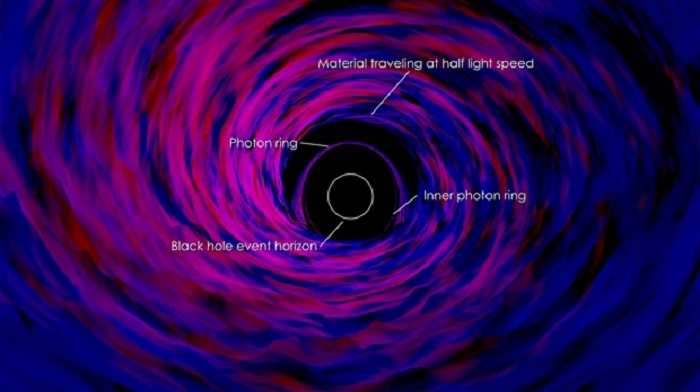.

This annotated image labels several features in the simulation, including the event horizon of the black hole. Credit: NASA's Goddard Space Flight Center/J. Schnittman, J. Krolik (JHU) and S. Noble (RIT)
.
Astronomers at NASA, Johns Hopkins University and the Rochester Institute of Technology have confirmed the way stellar-mass black holes produce their highest-energy light.
Black holes are the densest objects known. Stellar-mass black holes form when massive stars run out of fuel and collapse, crushing up to 20 times the Sun's mass into compact objects less than 75 miles (120 kilometres) wide.
Using a supercomputer simulation of gas flowing into a black hole, the team have reproduced a range of important X-ray features long observed in active black holes.
"Our work traces the complex motions, particle interactions and turbulent magnetic fields in billion-degree gas on the threshold of a black hole, one of the most extreme physical environments in the universe," said lead researcher Jeremy Schnittman, an astrophysicist at NASA's Goddard Space Flight Center.
Gas falling toward a black hole orbits and accumulates into a flattened disk. The gas in this disk spirals inward, becoming compressed and heated as it nears the centre. Ultimately reaching temperatures up to 20 million degrees Fahrenheit (12 million C) the gas shines brightly in low-energy, or soft, X-rays.
Over 40 years, observations showed that black holes also produce "hard" X-rays, with energy tens to hundreds of times greater than soft X-rays. This implies the presence of correspondingly hotter gas, with temperatures reaching billions of degrees.
The study bridges the gap between theory and observation, demonstrating that both hard and soft X-rays inevitably arise from gas spiraling toward a black hole.
The team modelled the inner region of a black hole's accretion disk, tracking the emission and movement of X-rays, and compared the results to observations of real black holes.
Our work traces the complex motions, particle interactions and turbulent magnetic fields in billion-degree gas on the threshold of a black hole, one of the most extreme physical environments in the universe.
Scott Noble, a research scientist at the Rochester Institute of Technology, developed a computer simulation solving all of the equations governing the complex motion of inflowing gas and its associated magnetic fields near an accreting black hole. The rising temperature, density and speed of the infalling gas dramatically amplify magnetic fields threading through the disk, which then exert additional influence on the gas.
The result is a turbulent froth orbiting the black hole at speeds approaching the speed of light. The calculations simultaneously tracked the fluid, electrical and magnetic properties of the gas while also taking into account Einstein's theory of relativity.
Over the years, improved X-ray observations provided mounting evidence that hard X-rays originated in a hot, tenuous corona above the disk, a structure analogous to the hot corona that surrounds the sun.
"Astronomers also expected that the disk supported strong magnetic fields and hoped that these fields might bubble up out of it, creating the corona," Noble explained.
The team used the data to track how X-rays were emitted, absorbed, and scattered throughout the accretion disk and the corona region. Combined, they demonstrate for the first time a direct connection between magnetic turbulence in the disk, the formation of a billion-degree corona, and the production of hard X-rays around an actively "feeding" black hole.
The study was based on a non-rotating black hole. The researchers are extending the results to spinning black holes, where rotation pulls the inner edge of the disk further inward and conditions become even more extreme.
Quelle: SEN
